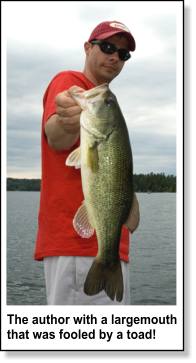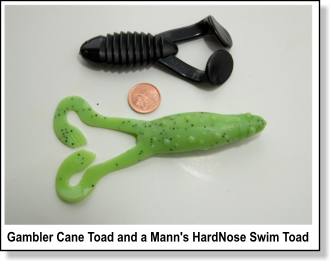Toad Rigging Tactics
By
Tim Allard
 When
conditions are right, I like nothing more than catching largemouth bass on
soft-plastic top water baits. Whether you like hollow-bodied frogs or the
slimmer profile of toads (also called swimming frogs), both are
outstanding baits. In this article, I'll cover some tips for rigging and
fishing toads to put more largemouth bass in your boat this season. When
conditions are right, I like nothing more than catching largemouth bass on
soft-plastic top water baits. Whether you like hollow-bodied frogs or the
slimmer profile of toads (also called swimming frogs), both are
outstanding baits. In this article, I'll cover some tips for rigging and
fishing toads to put more largemouth bass in your boat this season.
The Right Bait
Many companies make a soft-plastic toad. The biggest distinguishing
features are bait size and the style of feet. Toads range from 3.5- to
5.0-inches in length. You'll want both in your boat as sometimes a smaller
bait will outfish a larger one and vice versa depending on the conditions
and mood of the fish.
When it comes to feet, anglers can select a paddle-style foot, like those
on Gambler's Cane Toad. These paddle-style feet, will make a plopping
sound when brought through the water. The other option is flatter legs and
feet that are almost like twister-tails, Mann's Hard-Nose Swim Toad is an
example. These slimmer appendages can be the better choice in thicker
vegetation and produce a scurrying, splashing sound when retrieved.
One Hook Rigging Option
When it comes to rigging, a wide gap hook between 3/0 will work for
smaller toads, while 4/0 to 5/0 is the norm for larger baits. Rig toads
Tex-posed, with the hook point coming out of their backs. Some baits have
a groove in the top of baits for the hook to sit in to prevent snags.
Also pay attention to the hook eye of hooks,
inferior quality ones will not have a fully closed eye. If using braid
this tiny opening can sometimes let line slip free when battling big fish
in heavy cover. If anything, this risk is another reason to use the
double-loop qualities of a polymer knot. You can also tie a small section
of line on first or use a drop of glue to fill the gap in the hook.
Another Rigging Option
Other options are available for rigging toads. A bait-keeper hook,
featuring a barbed spear or coil that is connected to the hook eye can be
used to keep toads properly rigged on the hook. Examples include the Zoom
Horny Toad hook or a straight-shank hook teamed with a #44 HitchHiker coil
from Tru-Turn. Alternatively, adding glue to hooks will help the bait's
nose stay up on the hook eye longer. Worth noting is that Mann's HardNose
Swim Toads are particularly effective at holding hooks in place than many
other products available.

Consider Cutting
Although it might seem counter intuitive, cutting toad bodies can add
more action and performance to your baits. Depending on the size of the
hook, you may find that toad legs will occasionally fowl in its gap.
Downsizing the hook or not using a wide-gap model is an option if you
encounter this problem. An alternative is trimming off some of the plastic
from the legs for baits that have paddle-style feet. Cutting off the top,
rounded portion (still leaving on half the foot) will reducing fouling.
Reusing Baits
Lastly, to get a few more fish from each bait, when the nose is torn
from hook sets and won't hold a hook on a Texas-rig cut the ripped section
of the nose off. Remove off ¼ inch or so, and may be able to fish this
bait again, but will likely need to go down a hook size. The trim
influences how well the bait pulls through weeds, but in sparse conditions
the bait should be fine. Another option is glueing tears in plastic back
together.
Try these toad modification tricks and rigging
tips this season. Don't forget to use heavy super lines, between 40 to
60-pound test and a high-gear ratio reel to be able to pull bass from
thick cover. Lastly, if you don't already own a rod specifically designed
for throwing these baits (like G. Loomis' Frog Rod) consider investing in
one. They let you cast these baits further and provide enough power in the
mid section to muscle big fish.
|


 When
conditions are right, I like nothing more than catching largemouth bass on
soft-plastic top water baits. Whether you like hollow-bodied frogs or the
slimmer profile of toads (also called swimming frogs), both are
outstanding baits. In this article, I'll cover some tips for rigging and
fishing toads to put more largemouth bass in your boat this season.
When
conditions are right, I like nothing more than catching largemouth bass on
soft-plastic top water baits. Whether you like hollow-bodied frogs or the
slimmer profile of toads (also called swimming frogs), both are
outstanding baits. In this article, I'll cover some tips for rigging and
fishing toads to put more largemouth bass in your boat this season.